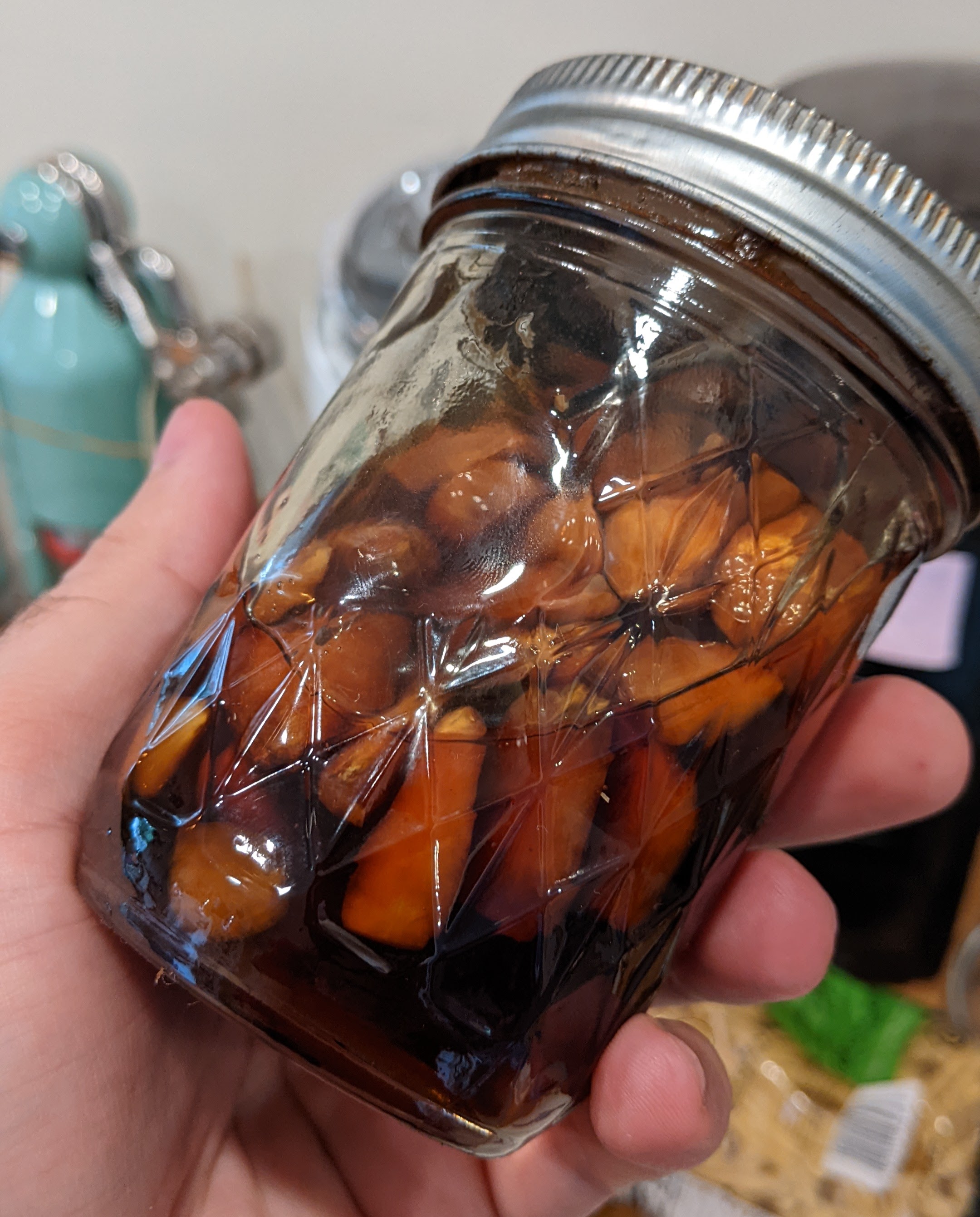Photonics Engineer by day, indie RPG writer by night, especially interested in open/CC games.
See my stuff here: http://awkwardturtle.games
- 6 Posts
- 8 Comments
- AwkwardTurtle@beehaw.orgtoFood and Cooking@beehaw.org•Fresh batch of limoncello and lemon peel powder.4·1 year ago
Ooo, fantastic. I’ve been doing sugar extractions of lemon zest for a mead recently, and we tried drying and blitzing the zests after filtering.
For us the powder was nice (partly because it got a bit candied during the process) but fairly mild in taste. I think it could still absolutely be fun to use to sprinkle on desserts of drinks, for visuals if nothing else.
- AwkwardTurtle@beehaw.orgtoHomebrewing - Beer, Mead, Wine, Cider@sopuli.xyz•How to backsweeten naturally?English1·1 year ago
Having recently tried the filtering thing, it’s still a roll of the dice unless you’re using the much more expensive professional grade filters.
It does get your mead clear as hell though, and removes a ton of off flavors.
I’ve almost certainly go too many books, but for me RPG books are two things:
- Something I do or plan to use the actual contents of. Whether that be rules, tools, or adventures.
- Physical objects that are nice to look at and hold.
Happily the indie RPG scene is very good at making books that cover both of those categies. I will once in a while go through the collection and give away books that I both don’t think I’ll ever use, and also aren’t nice enough as objects to be worth keeping around.
I also have a number of magazine bins filled with zines, which I love but also desperately needs to be pared down.
Also because I will take any opportunity to share a shelfie:
Desk RPG shelf of “close to hand” stuff (and also tall books because they don’t fit on the other shelves).

Ancillary bookshelf of RPG stuff:

I guess the question is whether your goal is to make all three stats equally useful, or to make sure the attribute damage mechanic is used equally on all three stats.
If it’s the former then increasing the utility of the other two stats with initiative, magic, dodging, etc. would be a good way to go.
If it’s the latter then making sure enemies have a wide variety of attacks works. Psychic/psionics, poison, ensnaring, soul damage, etc. would all help.
Although I do like applying damage to other stats where appropriate, I don’t actually think you need to if what you’re worried about is balancing them.
STR is the more important attribute if you’re consistently getting into combat. All these games share an ethos that combat shouldn’t be a hugely frequent thing at the table. In that context, the stats are a lot more “balanced”. DEX is by far the most called for Save, in my experience, plus it’s how you go first in combat.
WIS/CHA is a little trickier, depending on your individual campaign. Although in Mausritter specifically casting spells can cause WIL damage.
FWIW this is something I grappled with a bit for my own Odd/Cairn hack (slightly exacerbated by some other rules changes), and I eventually came to the conclusion that I didn’t need rules changes to fix it. The only thing I really plan to do is make sure the included bestiary includes examples of damage to other attributes.
- AwkwardTurtle@beehaw.orgtoHomebrewing - Beer, Mead, Wine, Cider@sopuli.xyz•A basic mead primerEnglish2·1 year ago
I’m no expert, been doing it as a hobby for about five years now, but from my own experience I’ll make a few notes:
- Be prepared to wait for your mead to age out, especially if you go high ABV and pure honey with no additions. If you want fast turnaround do sweet, low ABV meads or make beer instead.
- Time forgives all sins. If your mead tastes like ass, simply wait long enough and it’ll probably taste great. Sometimes that time frame is 2 or 3 years, but it’ll (probably) get there eventually. Rack into a new vessel every once in a while as long as you’re seeing sediment collect at the bottom.
- Adding nutrients, especially adding it in steps during primary, makes a huge difference. As in, being able to drink your mead in 4 months rather than a year+. I’ve found the easiest way to do it is with Fermaid O and the TOSNA Calculator. There are more complex nutrient calculators out there if you want to get deeper into the math.
- I’ve also started adding O2 during primary fermentation, although I started it around the same time I started using yeast nutrient so I can’t really tell you how much of an impact it makes.
- I’ve personally found that doing one gallon batches just isn’t worth it, for all that I see it commonly online. Unless you’re doing low ABV mead, it’s going to take time to age out into something nice. At which point if it’s good, you’ll be disappointed you didn’t do a larger batch. It takes more setup equipment and 5+ gallon glass carboys are pricey, but if you have a local homebrew store getting a basic fermentation bucket (often found in beer homebrew kits) is very worth it. That also goes with getting actual airlocks which are cheap enough that I think it’s worth picking up to take less risks with your mead
- See if you can get your honey locally, and if they’ll cut you a deal on buying in bulk. If you can’t, webstaurantstore.com has surprisingly reasonable prices for delivering 5 gallon buckets of honey.
- Making your wine sweeter is a good way to make it taste good faster without having to age as long, but do give dry meads a try! They’re very nice!
- I have filtered mead (using basic plate filters and gravity), and it improved the taste and clarity more than I was expecting. No idea how successful it was at stabilizing it because I didn’t backsweeten afterwards. From my research, if you want 100% guaranteed stabilization from filtering you’re looking at some pretty expensive equipment and filters. By the same token the science behind chemical stabilization as talked about in the OP is not as cut and dry as I was hoping, so I don’t know that there are good guarantees anywhere for this.
- Edit: Do research first if you want to attempt a bochet. Boiling honey expands to 3x the original volume, and superhot molten sugar is one of the most dangerous things you can have splattering around in your kitchen!
It’s fantastic, as simple as just chucking some garlic into a jar with honey. Wait long enough and you get a really nice almost balsamic-y garlicy liquid to drizzle on stuff (I love it on pizza). I’ve also done it with some chopped up habanero included to make it spicy.
Insert usual caveats about being careful with fermenting food at home and doing your own research, and there being a small risk of botulism.

Yeah, I don’t know if that tracks. Wingspan has sold more than 1.3 million copies (as of September 2021) which is way way way more than the average board game sells.
I’d far more believe that they couldn’t keep up with production than they were intentionally limiting supply.